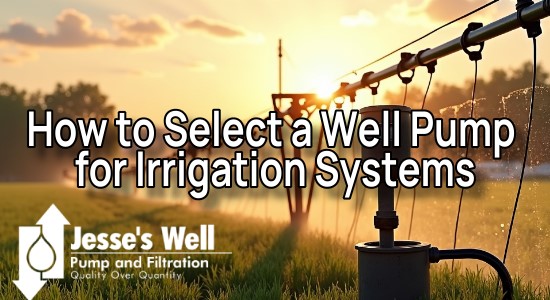
How to Select a Well Pump for Irrigation Systems
10/15/2025
How to Choose a Well Pump for Irrigation Purposes
If you’re setting up irrigation on your property, figuring out which well pump to use might feel like one of those small details that turn out to be a big deal. I’ve seen a lot of folks assume any pump will do, but that’s how you end up with weak pressure or uneven watering. The right well pump makes all the difference—it’s the heart of your irrigation system, keeping everything flowing smoothly and efficiently.
Understanding What Your Irrigation System Needs
Before you even think about brands or horsepower, you’ve got to look at what your irrigation setup actually demands. How many sprinkler heads are running? How far is the water source from the yard or garden? These details decide whether you need something basic or a pump with serious power. A small garden with a few sprinklers can run fine on a shallow well jet pump, but a larger field or a deep well is going to need something with more muscle—like a submersible pump.
Jet Pumps vs Submersible Pumps
This is the part that confuses people the most. Jet pumps are great for shallow wells, usually 25 feet deep or less. They sit above ground, pulling water up rather than pushing it. They’re easy to access and maintain, but they can struggle if your water source is deep. Submersible pumps, on the other hand, live underwater inside the well and push water up. They handle deeper wells better and usually run quieter. I’ve always thought of submersibles as the “set it and forget it” kind—once they’re in, they just work.
Calculating Flow Rate and Pressure
Flow rate is how much water you need, and pressure is how forcefully it moves. For irrigation, both matter a lot more than people expect. If your pump can’t keep up with the gallons per minute (GPM) your sprinklers demand, you’ll end up with dry spots. A typical residential irrigation setup might need between 10 to 20 GPM depending on how many zones or heads you’re running. Checking your sprinkler specs can give you a more exact number. Once you have that, make sure your pump can handle it comfortably without running at full capacity all the time—that’s how you get longer lifespan and fewer breakdowns.
Considering Water Depth and Well Recovery Rate
This part’s often overlooked. The depth of your well and how quickly it refills after pumping (the recovery rate) both influence what kind of pump you should buy. If you’ve got a low-yield well, a high-powered pump might drain it faster than it can recover, which can cause long-term issues. That’s why matching pump output to your well’s performance is just as important as meeting irrigation demand. Honestly, a local well contractor can test this for you if you’re unsure—it’s worth the small fee.
Durability and Maintenance
When it comes to irrigation, pumps tend to run longer hours during dry seasons, so durability matters. Stainless steel and cast-iron housings hold up best against wear, especially if your water has sediment or minerals. You’ll also want to make sure the pump has an accessible priming port or built-in check valve, so you’re not fighting airlocks or losing suction after a few weeks of heavy use. I’ve seen too many systems fail just because of small installation shortcuts that could’ve been avoided with a better-built pump.
Power Supply and Energy Efficiency
Most irrigation well pumps run on either 115V or 230V power, but your available supply will narrow the options fast. If your irrigation system runs daily, an energy-efficient motor can save you quite a bit over time. Some newer pumps come with variable speed motors that adjust automatically depending on water demand. They’re pricier up front but tend to pay off in lower electric bills and longer lifespan. Basically, if you’re watering a large property, it’s worth considering.
Matching the Pump to Your Irrigation Setup
Here’s a simple rule of thumb I like to use:
- Small garden or shallow well (less than 25 ft): Jet pump, easy to maintain, lower cost.
- Medium property with moderate depth (25–80 ft): Convertible jet pump or small submersible.
- Large property or deep well (80+ ft): Submersible pump for better efficiency and pressure.
These are general ranges, of course, but they give you a decent starting point. If you’re still unsure, it’s usually best to size slightly above what you think you’ll need—running a pump below its limit is easier on the system than pushing it too hard.
Signs You Might Need Professional Help
Even if you’re pretty handy, installing or upgrading a well pump isn’t always a DIY job. You’re dealing with electricity, plumbing, and sometimes tricky well depths that can cause headaches fast. If your irrigation pressure fluctuates, the pump cycles on and off too often, or the system suddenly loses prime, those are signs something’s off. In my experience, it’s better to have a professional inspect it before the problem gets worse—and costlier.
Final Thoughts
Choosing the right well pump for irrigation isn’t about guessing—it’s about matching the pump to your water source and your system’s demand. The best setup is one you barely have to think about once it’s running, and that’s what Jessie’s Well Pump Repair focuses on. Whether it’s figuring out flow rate, testing pressure, or helping you pick between a jet or submersible pump, we’ve seen what works for every type of property here in South Carolina. And if you’re not sure where to start, just ask. Sometimes a short conversation saves you a lot of trial and error down the road.

